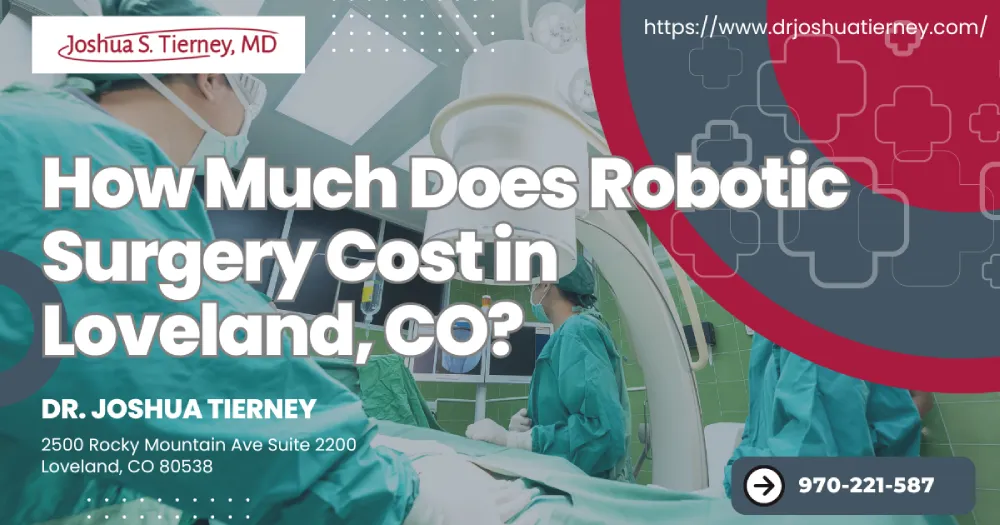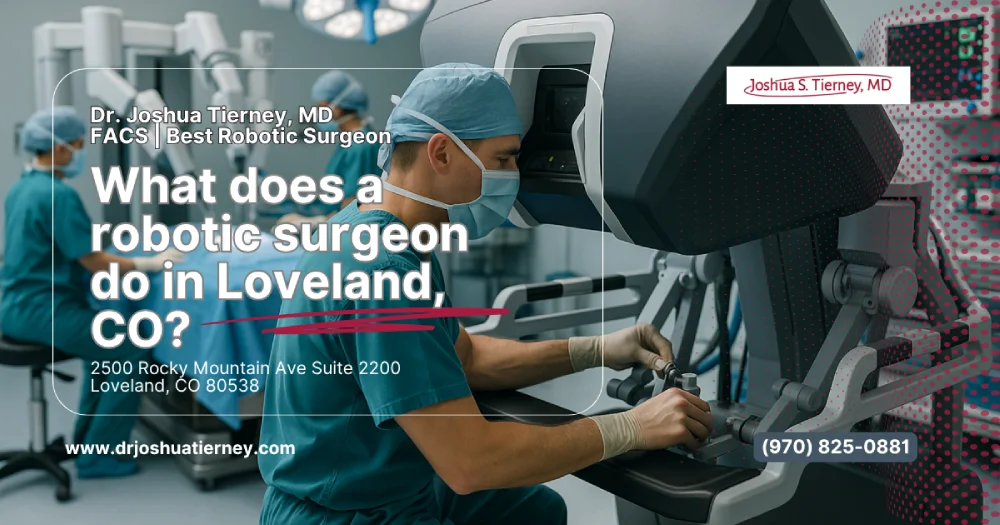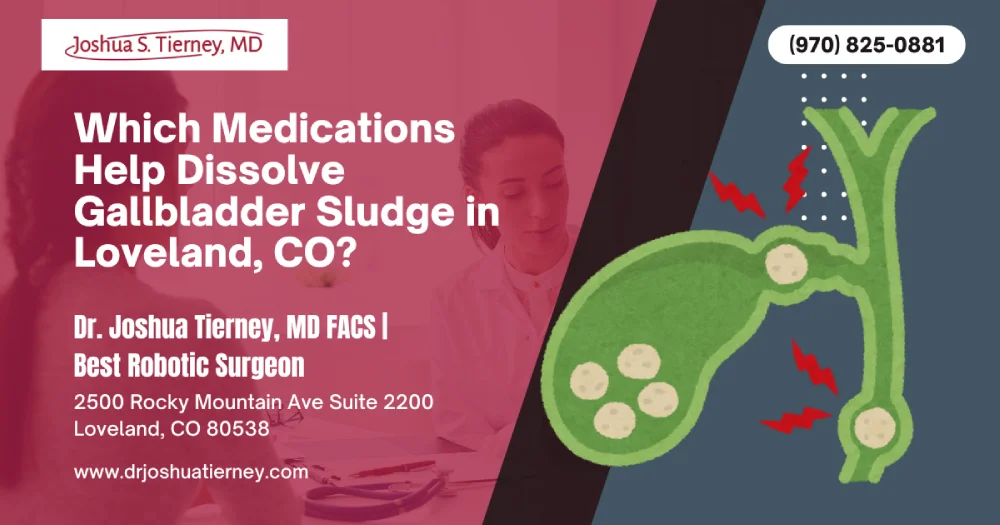Choosing a minimally invasive, robotic-assisted surgery in Loveland can feel overwhelming, especially when you’re balancing clinical benefits, insurance plans, and your monthly budget. As a fellowship-trained surgeon who treats patients across Northern Colorado—including Greeley, Fort Collins, and Loveland—I’ve written this guide to demystify pricing and help you make the best care decisions for your health care needs.
Key Takeaways
- Sticker prices for robotic surgery in Loveland range from $12,000–$25,000, depending on medical center, surgeon, and case complexity.
- Hospital and facility fees can reach 60 % of the total. Choosing an outpatient clinic in Loveland or an ambulatory center can trim thousands.
- Insurance coverage, co-payment, and deductible status dictate what you actually owe. Always check with your insurance provider before you schedule an appointment.
- Robotic surgery uses small incisions and a robotic arm to perform an alternative to traditional open surgery, often resulting in less blood loss and faster recovery.
- McKee Medical Center, Medical Center of the Rockies, Banner Health–affiliated hospitals, and Poudre Valley Hospital in Fort Collins all list transparent prices online.
- Tierney and his team routinely negotiate self-pay discounts, bundle pricing, and payment plans to ensure every patient receives the best care possible.
Why Robotic Surgery Commands a Premium
Robotic surgery was designed to be less invasive than standard laparoscopic or open procedures. High-definition cameras, wristed robotic tools, and 3-D visualization offer greater precision inside the operating room. Yet each robotic arm, console, and service contract raises overhead for health care facilities—costs that must be recovered in a timely manner to keep surgical services available.
In Northern Colorado, the da Vinci platform alone costs upward of $2 million, and yearly maintenance adds another $100 k. When hospitals properly bill your claims, they amortize that investment over hundreds of surgical procedures, increasing the per-case fee by roughly $2,000–$3,000. Even so, most insurers treat robotic-assisted surgery as an extension of general surgery, reimbursing under the same CPT codes.
Understanding Robotic Surgery Pricing in Loveland
Below is an expanded cost framework that applies whether you’re getting heart and trauma care at a Level II trauma center, a hysterectomy at an outpatient surgery clinic, or labor and delivery services in the same health system.
Core Cost Components
- Facility or medical center fee
- Surgeon’s professional fee (board-certified in general surgery)
- Anesthesia fee
- Supply costs for robotic tools and disposable drapes
- Pharmacy, lab work, and critical care monitoring
- Postoperative care, including pain control, physical therapy, and follow-up visits
Typical Loveland-Area Robotic Fees
| Procedure | Robot-Assisted Cost | Laparoscopic Cost | Open Surgery Cost | LOS |
| Gallbladder Removal (Cholecystectomy) | $13,000 | $8,500 | $7,200 | 0 |
| Hernia Repair | $15,500 | $9,200 | $8,100 | 0 |
| Prostatectomy | $21,000 | $17,800 | $14,600 | 1–2 |
| Hysterectomy | $18,400 | $12,600 | $11,200 | 1 |
| Colon Resection | $24,900 | $19,300 | $17,700 | 3–4 |
Figures are composites from Banner Health price lists, UCHealth Home Locations, and private insurance claims in a timely manner.
Comparing Surgical Options: Robotic vs. Laparoscopic vs. Open
When weighing surgery options, remember that robotic-assisted techniques are an evolution of minimally invasive laparoscopy, not a completely different discipline. Both use small incisions, but robotic consoles give your care team finer instrument control and a stable 3-D view. That advantage often translates into:
- Lower blood loss, which can mean fewer transfusions and shorter stays in intensive care units.
- Reduced postoperative pain, allowing for earlier ambulation and less reliance on opioids for providing adequate pain control.
- Faster return to work, a critical point for self-employed patients concerned about coverage change or insurance loss.
Hospital, Clinic, and Trauma Center Pricing Differences
Loveland and the greater Northern Colorado corridor host three major hospitals with robotic capability:
- McKee Medical Center in Loveland (Banner Health)
- Medical Center of the Rockies in Loveland (Level II trauma designation)
- Poudre Valley Hospital in Fort Collins (UCHealth)
A surgery in Loveland performed at an inpatient hospital may carry extra line items—radiology, lab, or critical care—that an outpatient clinic doesn’t bill. If your medical or heart and trauma care risk is low, an ambulatory surgery center can cut costs 15–25 %.
Greeley residents often travel west to Loveland for robotic procedures because the pricing difference, even after mileage, remains favorable compared with some Greeley-based facilities.
Surgeon and Anesthesia Fees
A board-certified surgeon in Loveland who is also fellowship-trained in robotic-assisted surgery typically charges $1,800–$3,500 per case. Longer, invasive procedures like colon resections take more operating-room time, so anesthesia fees climb proportionally. Each insurance plan calculates allowable rates differently, so always check with your insurance provider or contact our office for a Good Faith Estimate.
Insurance Plans, Co-Payments, and Claim Workflows
Whether you have a PPO, HMO, or high-deductible HSA plan, three items dictate what you pay:
- Deductible remaining
- Coinsurance percentage
- Maximum out-of-pocket limit
Ask your insurer if robotic-assisted surgery is categorized as a separate tier. Most do not up-charge, but errors happen. If an insurance plan change occurs between scheduling and surgery day, notify our billing team so we can properly bill your claims. Missing paperwork leads to denials that might shift thousands of dollars back to you.
Ways to Lower Your Out-of-Pocket Cost
- Self-pay bundles: Many health care facilities offer 20–40 % off for upfront payment.
- Facility choice: The same surgeon may operate at two venues; choose the less expensive location when clinically safe.
- Timing: If your deductible resets in January, scheduling a December operation can leverage benefits you’ve already earned.
- Pre-habilitation: Optimizing nutrition and exercise can shorten hospital stays and reduce critical care costs.
- Financial-assistance programs: McKee Medical Center, Medical Center of the Rockies, and Poudre Valley Hospital all extend charity care up to 400 % of FPL.
Sample Patient Journey: From Consultation to Postoperative Care
- Schedule an appointment at our surgery clinic; we gather imaging and discuss treatment plans.
- Our care team verifies benefits, checks for prior authorization, and requests in-network clearances.
- In the operating room, a robotic arm controlled by your surgeon performs the minimally invasive tasks through 5–8 mm incisions.
- Postoperative care includes early ambulation, multimodal pain control, and diet progression.
- You return for follow-up at the clinic in Loveland within 7–10 days; most patients resume desk work in one week.
The Tierney Difference: Commitment to Best Patient Experience
Tierney and his team blend evidence-based medicine with transparent communication. From complex trauma center consults to elective hernia repairs, our goal is to deliver the highest patient care standards:
- Prompt answers to frequently asked questions via patient portal
- Health connection resources linking you to outpatient physical therapy, laboratory, and imaging
- Coordinated heart and trauma care when ICU or critical care backup is needed
- Flexible scheduling to accommodate insurance plan changes, coverage gaps, or COBRA transitions
- A promise to file all claims in a timely manner so you avoid avoidable denials
Conclusion
Robotic-assisted surgery offers an exciting, less invasive alternative to traditional open surgery—and yes, it costs more than standard laparoscopy. However, by choosing an in-network medical center in Loveland, verifying benefits early, and negotiating where appropriate, you can keep your personal expenses in check.
Ultimately, the combination of shorter recovery, smaller scars, and reduced blood loss often justifies the premium, especially when long-term quality of life is factored in. If you still have cost questions or need individualized treatment plans, contact our office anytime.
FAQs
What if my insurance denies robotic surgery as “not medically necessary”?
File an appeal immediately. Provide clinical notes, imaging, and peer-reviewed articles showing robotic-assisted outcomes equal or superior to laparoscopy. Our care team will supply supporting letters and resubmit claims, often overturning the initial denial within 30 days.
Can I switch hospitals if I find a better price after scheduling?
Yes, but notify both facilities quickly. Operating-room blocks book months ahead, so rescheduling early avoids cancellation fees. Make sure your surgeon has admitting privileges at the new location and that your insurance plan still lists the facility as in network.
Are anesthesia bills separate from the surgeon’s fee?
Usually. Anesthesiology groups contract independently with hospitals. Verify that every provider—from anesthesiologist to pathologist—is in network, or request a single “global fee” quote that bundles their services with the main facility charge.
How does robotic surgery affect maternity or labor and delivery coverage?
It doesn’t. Obstetric benefits and surgical benefits are separate line items on most insurance plans. Robotic gynecologic procedures like myomectomy won’t change how your future labor and delivery claims are processed or covered.
Will tiny robotic tools limit what procedures can be done?
Not really. Wristed instruments allow greater range of motion than human wrists, enabling complex suturing and reconstruction through small incisions. That versatility expands, rather than limits, the list of related procedures we can offer robotically.
What postoperative care include after a robotic procedure?
Expect detailed wound care instructions, medication review for pain control, and early ambulation guidelines to prevent blood clots. Follow-up visits, lab checks if needed, and rapid messaging with our clinic are included in the global surgical package for 90 days.
Does Loveland have Level II trauma capability for emergencies during elective robotic cases?
Yes. Medical Center of the Rockies is a verified Level II trauma center with heart and trauma care teams on standby, so any unforeseen complication can be managed without transfer delays.
How do I prepare financially for potential coverage change or insurance loss?
Consider short-term gap policies or COBRA enrollment if you expect job transitions. Our financial counselors can estimate worst-case out-of-pocket costs and arrange payment plans to bridge any lapse in major medical coverage.
Is robotic surgery appropriate for elderly patients with multiple comorbidities?
Often, yes. Smaller incisions translate to less physiologic stress and quicker mobilization, which can be safer for seniors. Pre-op evaluations with cardiology and critical care specialists ensure that benefits outweigh risks for each individual.
What distinguishes Dr. Tierney from other surgeons in Loveland?
Dr. Joshua Tierney is board-certified in general surgery, fellowship-trained in minimally invasive and robotic-assisted techniques, and committed to delivering the best patient experience. His multidisciplinary team coordinates every phase—from pre-hab to postoperative checkups—so you receive seamless, high-quality care.









